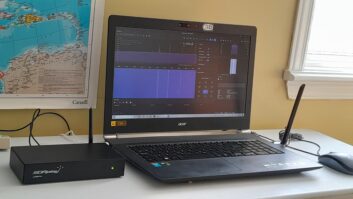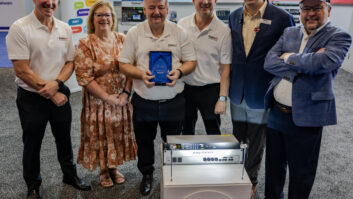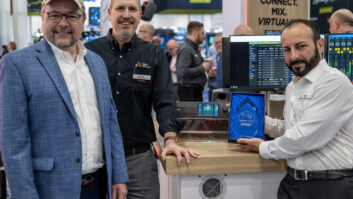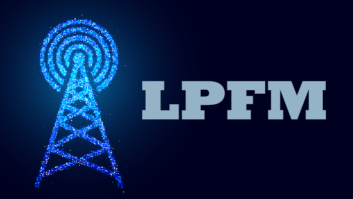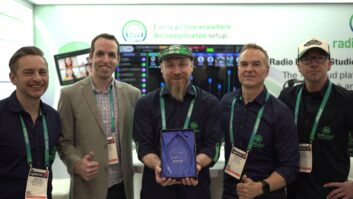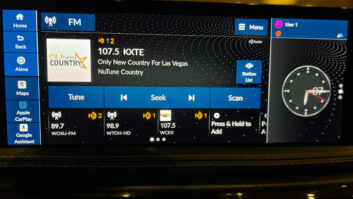Beta-testing Matrix GSM In WashingtonI was asked to take part in a test of the Matrix with GSM module for Comrex in the heart of the nation’s capital.
The technical folks in Devens, Mass., were anxious to check out the wireless performance aspects of the Matrix in areas with fairly high cellular RF density.
The company had performed tests in many major cities both at home and around the globe, all to satisfying ends. Washington was no exception.
In many situations, the Comrex Matrix was mounted in an automobile with a magnetic antenna on the roof. The car was then driven through the city through live and dead spots of cellular activity, and put through its paces in that manner.
I opted instead for a stationary indoor test; this being Washington, there are indoor press conferences all the time. For a news/talk station, a live unwired feed with good fidelity means victory in the race to get the story on the air. If the Matrix with the GSM option could punch through the walls here, news stations everywhere would want to know.
The Matrix unit I had was set up in a third-floor office at 19th and M Streets in downtown D.C., only a couple of blocks from NAB headquarters. The magnetic antenna was mounted on a large metal file cabinet and placed near a window.
I dialed in to the Comrex test line in Massachusetts on the Matrix, and called the office on my own cell phone to coordinate the test and conduct troubleshooting if necessary.
At first, audio quality through microphones at both ends was quite good, but I was experiencing several dropouts, and the line integrity shown in the display was at 5, considerably low.
As it turned out, my own cell phone, which was being used less than three feet from the antenna, was the culprit. Once it was turned off, line integrity jumped to 25 and I enjoyed a stable and good-sounding connection.
There was some subtle and distant gurgle in the headphones, as might be expected from a digitized and compressed audio stream, but it was well below any disagreeable threshold.
It is an indisputable accomplishment to be able to pump fully airable audio content over a cell connection. My static test in what is a highly charged RF region came out quite satisfactory.
Comrex representatives say the GSM wireless capabilities of the Matrix are not appropriate for music transmission, and there are still a number of telephone devices and services that remain incompatible. Moreover, interference from my own phone revealed that the Matrix with GSM is susceptible to cell phone interference, but only when up close to the antenna.
This is not a condemnation of the technology. Wireless interference is becoming quite widespread, and at least 27 states have experienced situations where emergency police and rescue radio services have been blanked out by RF interference from strong wireless sources such as cell towers. This may not change in the immediate future.
The Comrex Matrix does exactly what it was designed to do, especially when used in a wireless fashion. However, one must be prepared to deal with environmental and technical issues at a remote broadcast site. If you are at a ballgame or at an outdoor promotional event with no cell tower in sight, you should be home free.
If you are doing a live hit from the airport concourse or a concert where up-close or concentrated cell activity may clobber your line integrity, you might be best off having a POTS or ISDN backup in place for safety.
– Alan R. Peterson The author is a technical advisor to RW, and production/imaging director for WMET(AM), Washington, D.C.Modesto is a farming community in Northern California. While small in population, it has been the center of national news for two years thanks to the Gary Condit/Chandra Levy story and the Laci Peterson murder trial.
Product CapsuleThumbs Up:
Better-than-FM quality on speech in GSM mode
Quick and easy to learn
Compatible with HotLine, Bluebox and Vector codecs
Thumbs Down:
Performance may be affected in high RF areas; see sidebar.
The media focus in that city has been tremendously heavy. While the City of Modesto’s response to all types of electronic and print media has been professional and “big city,” the telecomm infrastructure remains a challenge.
Beyond line of site
For Clear Channel’s News Talk 1530, KFBK, a major news talker in Northern California, the distance between Modesto and our RPU receive sites is beyond line of site, and phone/ISDN lines are not always available. Our reporters are forced to file stories and sound bites using cell phones, which can sound like talking into a paper cup. A new tool was needed.
That new tool was introduced to us by Eric Aiese of Comrex at an SBE (Chapter 43) luncheon. The Matrix GSM Module looked like a gift from heaven.
The GSM module, named after the Global System for Mobile Communications, attaches to the Matrix platform – either a POTS or ISDN codec – with just the change of a module.
The station owned a Matrix with the POTS and ISDN codecs, so we had everything we needed. When the beta test set arrived, we set up GSM service with a vendor, T-Mobile, who offered 3,000 minutes per month at a reasonable flat rate. Insert the vendor-supplied SIM card and the module is ready to go.
No time to lose
The afternoon the beta set arrived, the FM promotions department grabbed it for a remote scheduled for later that day. With about five minutes of training for the operator, out the door it went; it was an instant success.
I could hear a slight digital artifact, but the audio was more than acceptable for FM quality. Ease of setup and reliability were qualifying factors. Two more FM remotes were completed with the Matrix that week.
The next week the KFBK newsroom pressed it into service for news feeds around town. Greater confidence was building for the GSM Matrix. A couple of days later the Matrix went to Modesto with KFBK reporter Chris Filippi. He immediately started filing live reports from the Stanislaus County Court House in Modesto.
The Matrix was used as well for the gubernatorial inauguration of Arnold Schwarzenegger. The location for radio reporters did not allow for an RPU shot, and no phone lines were available. The GSM performed well for a long-form broadcast by the KSTE(AM) morning show hosts, Armstrong & Getty.
The audio quality was fine for this format. On this broadcast there was no hint of digital artifacts on the live audio. The other radio reporters, who had to file on cell phones, were envious.
As a side note, cell service in the heart of downtown Sacramento was so heavy, making calls was nearly impossible. But the GSM service was clear of users, with signal strength of more than 27.
The change in quality was incredible. We were finally airing audio that did not sound like a cell phone. Filippi was able to play his sound bites into the Matrix mixer instead of holding the cell phone microphone at some outboard speakers from his mini disk recorder. Again, the quality was fantastic.
We experimented with other cell phone interfaces, but it was just mixed audio over the regular cell circuits; no real improvement. Comrex has perfected a 7 kHz sound algorithm (9600 baud) over GSM service.
KFBK is part of the Clear Channel News Network and we feed pieces to the ABC Radio Network. The filed pieces were being heard on other Clear Channel stations and at the top-of-the-hour feeds from ABC. Again, we were pleased with the sound quality, and the reporters liked the portability of the unit and its ease of use. An optional battery pack is available and is a good idea for remote news applications.
The basic kit we assembled was: Matrix, GSM module, small mag-mount antenna, EV 635A microphone and cord, ear phones, adapter cord for MiniDisc output, accessory cord (to run the Matrix from a power outlet in car) and battery pack. The kit fits in a small hard case. I have the JL-2 quick charger but it is not with the kit.
Little to tweak
There is not much I would change with the Matrix GSM module. The reporters like the intuitive controls. All they need is good signal strength to call the studio Matrix receiver.
We had only one lock-up of the studio unit, but it was the beta unit. Our original unit was sent back to Comrex for upgrading and we have had no further trouble.
One thing I would like to see is an input that will take the lower output levels from digital sources like a MiniDisc, which has peaks in the -12 dB range. Also, the Matrix platform has only one headphone output. If we have two talents, a headphone amplifier has to be carried along, requiring power and an additional patch cord.
(According to the manufacturer, the Matrix features a -10 dB minijack input, which is designed for use with consumer-level equipment, such as MiniDisc players. Also, Comrex said, the second output on XLR has enough gain to drive most headphones.)
The A-Team methods for FM remotes and news reporting are still RPU, ISDN or Comrex Vector, but the versatility and ease of use from the Matrix GSM module expands the ability to set up remotes or file fast breaking news with the quality required for our stations.

